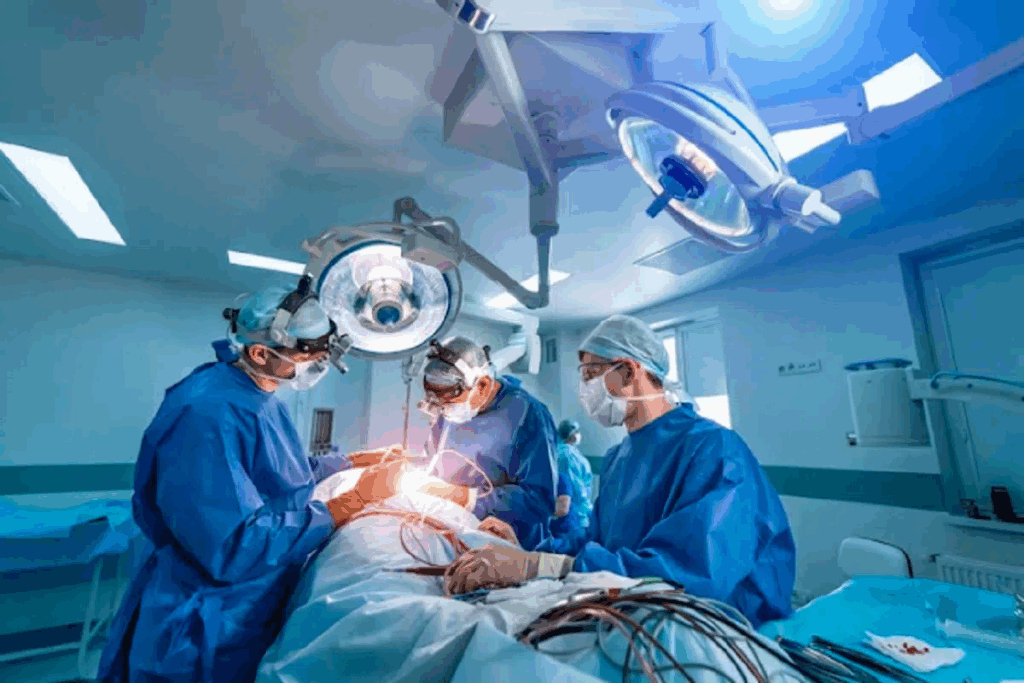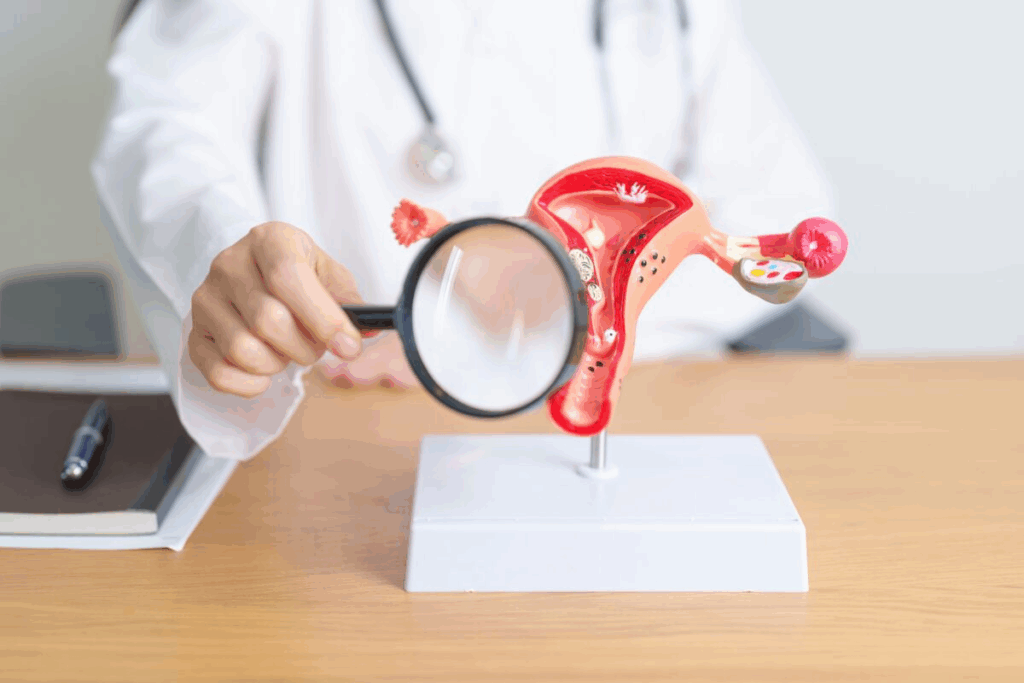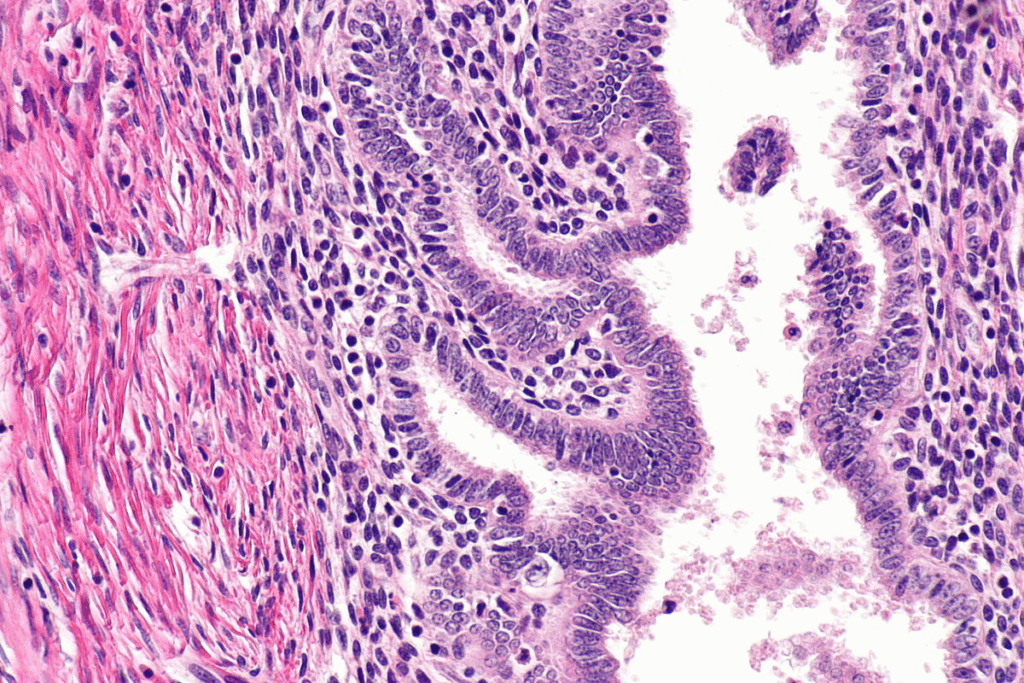Last Updated on October 31, 2025 by Saadet Demir

Uterine fibroids are common in many women. They can cause pain, heavy bleeding, or infertility. When symptoms get bad, surgery for fibroids in the uterus is often needed. Explore 7 powerful surgery for fibroids in uterus options. Our quick guide covers the best removal procedures for relief.
Dealing with fibroid tumor surgery can be scary. But, with the right info and support, women can choose wisely. At Liv Hospital, we focus on our patients. Our team is skilled in many surgeries for fibroids. We guide and reassure you every step of the way.

Uterine fibroids, or leiomyomas, are non-cancerous tumors in the uterus. They can cause symptoms that might need surgery. We’ll look at what these growths are, symptoms that might need surgery, and how doctors decide on surgery.
Uterine fibroids are non-cancerous growths in or around the uterus. They can be different sizes, numbers, and locations. These growths are common among women of reproductive age. The exact cause is unknown, but genetics, hormones, and environment play a role.
Symptoms of uterine fibroids can vary. They include heavy menstrual bleeding, long periods, pelvic pain or pressure, and pregnancy complications. The severity and impact of these symptoms on a woman’s quality of life often determine the need for surgical intervention. For example, heavy bleeding can cause anemia, and pain can affect daily life.
Before surgery, a detailed diagnostic process is done. This includes a pelvic examination, ultrasound, and sometimes MRI. These tests help find the size, number, and location of the fibroids. They also check how they affect surrounding areas, helping choose the right surgery.
It’s important to understand the diagnostic process and symptoms of uterine fibroids. This helps patients make informed decisions about their treatment. We work with patients to find the best treatment plan for their specific needs.

Myomectomy is a surgery that removes fibroid tumors but keeps the uterus. This makes it a top choice for women who want to keep their fertility options open. It’s key for those with uterine fibroids who want to stay fertile.
There are different ways to do myomectomy, each with its own benefits:
Myomectomy is best for women who:
Talking to a healthcare provider about your situation is key. They can help weigh the pros and cons.
Recovery times differ based on the surgery type. Most women can get back to normal in a few weeks. Myomectomy can also boost fertility by removing fibroids that block conception or pregnancy.
Myomectomy’s main benefits are:
Hysterectomy is a big surgery for women with uterine fibroids. It removes the uterus, solving fibroid problems for good.
There are many ways to do a hysterectomy. Each method has its own good points and when it’s best to use it. These include:
A study in the Journal of Minimally Invasive Gynecology says the choice depends on many things. These include how big the fibroids are, the patient’s health, and the surgeon’s skill (1).
| Hysterectomy Approach | Recovery Time | Scarring |
| Abdominal | 6-8 weeks | More noticeable |
| Laparoscopic | 2-4 weeks | Less noticeable |
| Robotic | 2-4 weeks | Minimal |
| Vaginal | 2-4 weeks | No external scarring |
Hysterectomy is often suggested for women with big fibroids, bad symptoms, or when other treatments don’t work. Jennifer Jacobs, a patient, said, “The surgery changed my life, ending the pain and heavy bleeding from my fibroids.”
“Hysterectomy should be considered when the benefits outweigh the risks, and other treatments are not suitable or effective.”
Hysterectomy is a lasting fix for uterine fibroids. It stops fibroid symptoms and prevents them from coming back.
But, it’s a big decision that needs careful thought. Talking to a doctor about how it might affect hormones and your mind is very important.
Submucosal fibroids can be treated with hysteroscopic fibroid removal. This method doesn’t need any cuts outside the body. It’s perfect for women with fibroids that grow into the uterine cavity, causing big problems.
The hysteroscopic procedure starts with a thin, flexible scope going through the vagina and cervix into the uterus. This scope has a camera and tools for surgery. It lets the surgeon see and remove the fibroid. The whole thing is done under general anesthesia or conscious sedation.
This method has many good points. It means less pain after surgery, quicker recovery, and it might help women keep their fertility. But, it’s mainly for submucosal fibroids. It might not work for all types or sizes of fibroids.
Recovering from this surgery is usually fast. Most women can get back to their normal life in just a few days. How fast you recover depends on your health and the surgery details.
| Procedure | Recovery Time | Fertility Preservation |
| Hysteroscopic Removal | 1-3 days | Yes |
| Open Surgery | 4-6 weeks | Varies |
Laparoscopic techniques have changed how we remove uterine fibroids. They offer a less invasive method with faster recovery times. This surgery, also known as minimally invasive surgery, uses small incisions. A camera and tools are inserted to remove the fibroids.
Laparoscopic myomectomy is a common method for removing fibroids. It involves cutting the fibroid from the uterus and removing it through small openings. The choice of method depends on the fibroid’s size, number, and location, and the patient’s health.
Laparoscopic surgery has a big advantage: quicker recovery times. Patients often feel less pain and can get back to their daily activities faster. “Laparoscopic surgery is a big step forward in treating uterine fibroids,” says a top gynecologist. “It balances effective removal with minimal harm.”
Also, the small incisions mean less scarring. This is a big plus for many. The precision of laparoscopic surgery helps in preserving the uterus. It can also improve chances of getting pregnant.
While laparoscopic surgery is mostly safe, there are risks. These include infection, bleeding, and damage to nearby organs. The chance of these problems is lower if the surgeon is experienced. It’s key for patients to talk about their risks and worries with their doctor.
Choosing surgery is a big decision. Laparoscopic surgery for fibroids is a good option for many women. It’s effective and less invasive. But, it’s important to think about the benefits and risks and consider your own situation.
Robotic-assisted surgery is a big step forward in treating uterine fibroids. It offers a less invasive option with faster recovery times. This method uses a robotic system to help surgeons, improving their precision and control.
Robotic-assisted fibroid removal surgery uses a high-tech robotic system. It lets surgeons do complex tasks with more ease and accuracy. The system has a console for the surgeon, robotic arms for the patient, and a 3D vision system.
This setup gives surgeons a clear view and precise control. It’s very helpful for delicate procedures like removing fibroids.
Robotic surgery has clear advantages over traditional methods. It offers better precision, which can mean less damage and fewer complications. It’s also less invasive, leading to less blood loss, pain, and quicker recovery times.
But, robotic surgery isn’t right for everyone. The choice depends on your situation and what your surgeon recommends.
Recovery from robotic-assisted fibroid removal surgery is usually faster than open surgery. Most people can get back to their normal activities in a few weeks. The results are promising, with many patients feeling much better after the surgery.
It’s important to follow your doctor’s instructions after surgery. This helps ensure the best recovery and results.
Choosing surgery is a big decision, and we’re here to support you. Robotic-assisted fibroid removal is one of the advanced options available. Our team is dedicated to helping you make informed decisions about your health.
Uterine Fibroid Embolization (UFE) is a non-invasive treatment for fibroids. It reduces fibroid size without surgery. This method is known for easing symptoms of uterine fibroids.
The UFE procedure cuts off blood to fibroids, causing them to shrink. We inject embolic material into the arteries that feed the fibroids. This is done under local anesthesia and takes about an hour.
UFE is best for women who don’t want surgery or can’t have it due to health issues. We look at fibroid size, location, and the patient’s health to decide if UFE is right.
Research shows UFE works well for many patients, reducing fibroid size and symptoms. But, like any treatment, it can have side effects. These include post-embolization syndrome, which may cause pain and fever.
| Success Rates | Potential Side Effects |
| 70-80% reduction in fibroid size | Post-embolization syndrome |
| Significant improvement in symptoms | Pain and fever |
We watch patients closely after UFE to manage side effects and help them recover. Knowing the benefits and risks helps women choose the best treatment for their fibroids.
Large fibroid tumors need special surgery to remove them well. We know big fibroids can really hurt a person’s life quality. So, we use special treatments for each case.
Abdominal myomectomy is a surgery to take out fibroids through the belly. It’s good for big fibroids that can’t be taken out easily. This method works well for people with many big fibroids.
This surgery can help a lot with symptoms. But, it takes longer to get better than other surgeries.
For hard fibroid cases, mixing treatments might be best. This could be surgery with uterine fibroid embolization (UFE) or hormone therapy.
| Therapy Combination | Benefits | Considerations |
| Abdominal Myomectomy + UFE | Effective for large fibroids, reduces symptoms | Requires surgical expertise, longer recovery |
| Hormonal Therapy + Surgery | Can shrink fibroids pre-surgery, making removal easier | Temporary solution, possible side effects |
Before surgery, treatments can help make removing big fibroids easier. Hormone therapy can make fibroids smaller before surgery.
We decide on these treatments based on the fibroids’ size and where they are. We also think about the patient’s health.
Choosing the right surgery for fibroids is a big decision. It’s important to know the different options. This helps you make a choice that’s right for you.
Several things affect the decision to have surgery. These include the size and location of the fibroids and your overall health. For example, big fibroids might need more serious surgery. But smaller ones could be treated with less invasive methods.
| Factor | Influence on Surgical Decision |
| Fibroid Size | Larger fibroids may require more invasive surgery |
| Fibroid Location | Location can affect the choice between laparoscopic and open surgery |
| Patient’s Overall Health | Health conditions can influence the suitability of certain surgical procedures |
It’s key to talk to your surgeon about the surgery. Ask about the benefits and risks. Also, ask about what to expect during recovery. Questions like “What are the chances of fibroid recurrence?” or “How will the surgery affect my fertility?” are important.
New studies show that less invasive surgeries are better. They lead to quicker recovery and fewer problems. Keeping up with the latest research helps you make a better choice.
Dealing with uterine fibroids and their treatment can feel like a big challenge. We’ve looked at different surgical options like myomectomy and hysterectomy. Each has its own good points and things to think about.
It’s important to know these differences to make smart choices about your health. Jennifer Jacobs’ story shows how important it is to speak up and make informed choices.
When talking to your doctor, think about what might affect your surgery choice. Ask the right questions. This way, you can make the best decision for your health.
Knowing about your fibroids and treatment options helps you take charge of your health. We’re here to help you make good decisions and get the care you need.
Common surgeries include myomectomy, hysterectomy, and hysteroscopic fibroid removal. Laparoscopic and robotic-assisted surgeries are also options. Each has its own benefits and risks.
Myomectomy removes fibroids but keeps the uterus. It’s good for those who want to have kids. Hysterectomy removes the uterus and is a more permanent solution.
Surgeons remove fibroids from the uterus during myomectomy. They use an abdominal incision, laparoscopy, or hysteroscopy. The method depends on the fibroids’ size, number, and location.
Hysteroscopic removal is for submucosal fibroids. It’s done through the cervix with a hysteroscope. It’s a minimally invasive procedure.
Laparoscopic surgery works for small or few fibroids. But, it’s not best for large ones. Abdominal myomectomy or other methods might be needed then.
Robotic-assisted surgery uses a robotic system. It helps surgeons remove fibroids more precisely. It’s a minimally invasive method.
No, UFE is not surgery. It shrinks fibroids by cutting off their blood supply. It’s a non-surgical option.
Choosing depends on fibroid size, number, and location. Your fertility goals and health also matter. Your surgeon’s advice is key.
Risks include infection, bleeding, and adhesions. Damage to organs and anesthesia issues are also possible. The risk varies by surgery type and individual factors.
Recovery time varies. Minimally invasive surgeries have shorter recovery times. Open abdominal surgery takes longer.
Yes, myomectomy preserves fertility. But, conceiving success depends on surgery extent, other fertility issues, and overall health.
New techniques like robotic-assisted surgery and treatments to shrink fibroids before surgery are improving outcomes. They also reduce recovery times.
Subscribe to our e-newsletter to stay informed about the latest innovations in the world of health and exclusive offers!
WhatsApp us